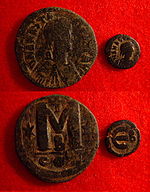- Nummus
-
 Nummi coins of the late reign of Anastasius I: in the right a 40-nummi coin (follis) and in the left a 5-nummi coin (pentanummium)
Nummi coins of the late reign of Anastasius I: in the right a 40-nummi coin (follis) and in the left a 5-nummi coin (pentanummium)
Nummus (Greek: νουμμίον, noummion), plural nummi (νοῦμμοι) is a Latin term meaning "coin", but used technically for a range of low-value copper coins issued by the Roman and Byzantine empires during late Antiquity.
In ca. 294, during the Tetrarchy, a new large bronze coin of ca. 10 grams weight and 30 mm diameter appeared. Its official name was apparently nummus, but it is usually known among numismatists as the follis.[1] The term nummus is thus usually applied solely to the 5th–7th century Byzantine issues. These were small, badly struck coins, weighing less than 1 gram, forming the lowest denomination of the Byzantine coinage. They were valued officially at 1⁄7,200 of the gold solidus but more usually rated to 1⁄6,000 or 1⁄12,000.[1] The nummus usually featured the profile of the reigning emperor on the obverse and the imperial monogram on the reverse, although some coins of Justinian I (r. 527–565) display its numerical value by the Greek numeral "A" instead.[1]
In 498, Emperor Anastasius I (r. 491–518) reformed the coinage by introducing multiples of the nummus, with denominations of 40 nummi, also known as a follis, 20 nummi (semifollis), 10 nummi (decanummium, δεκανούμμιον). These were also marked with Greek numerals representing their value: "M" for the follis, "K" for the semifollis and "I" for the decanummium. On the other hand, it appears that issue of the simple nummus was discontinued.[2] In 513, the weights of these coins were doubled, the pentanummium (πεντανούμμιον, 5-nummi coin marked with "E") introduced, and the minting of single nummi resumed.[3]
In 538/539, Emperor Justinian I introduced further changes to the 40-nummi follis, raising its weight to 25 grams. It was reduced again to 22.5 grams in 541/542, and further reductions followed until the century's end. At this time a new, 30-nummi coin (marked with "Λ" or "XXX") was introduced, but the single follis had ceased to be struck at Constantinople. It survived in the Exarchate of Carthage well into the 7th century however.[1][4] During the 7th century, the successive military and financial crises, led to increased reduction in the weight and a marked deterioration of the quality of bronze coinage: by the time of Constans II (r. 641–668), a follis weighed only 3 grams. Consequently, the denominations lower than the semifollis were practically unmintable and abandoned.[5] Thereafter the term nummus remained in use as a notional unit for 1⁄6,000 of the solidus, and in colloquial usage for "small change".[1]
References
Sources
- Grierson, Philip (1982), Byzantine coins, Taylor & Francis, ISBN 978-0-416713602, http://books.google.com/books?id=_kpOCsoUwksC
- Grierson, Philip (1999), Byzantine coinage, Dumbarton Oaks, ISBN 978-0-88402-274-9, http://www.doaks.org/publications/doaks_online_publications/byzcoins.pdf
- Hendy, Michael F. (1985), Studies in the Byzantine Monetary Economy c.300–1450, Cambridge University Press, ISBN 0-521-24715-2
- Kazhdan, Alexander, ed. (1991), Oxford Dictionary of Byzantium, Oxford University Press, ISBN 978-0-19-504652-6
See also
- Biscogniauxia nummularia, plant pathogen
- Bulbophyllum nummularioides, orchid plant species
- Eriogonum nummulare, buckwheat (or "money buckwheat") plant species
- Helianthemum nummularium, rockrose plant species
- Lysimachia nummularia, plant species
- Ziziphus nummularia, plant species
- Nummular dermatitis, skin disease
- Nummulite, fossil
- All pages with titles containing "nummu*", various other articles named after nummus because of the similarity to a coin
Currencies of the Byzantine Empire First period
(498 – ca. 700)Second period
(ca. 700 – 1092)Gold: Solidus or Nomisma (later Histamenon) · Tetarteron (from 960s) – Silver: Miliaresion (from 720) – Copper: FollisThird period
(1092 – ca. 1300)Gold: Hyperpyron – Electrum: Nomisma trachy aspron (Trikephalon/Manouelaton) – Billon: Aspron trachy (Stamenon) – Copper: Tetarteron · Half-tetarteronFourth period
(ca. 1300 – 1350s)Fifth period
(1367 – 1453)Related topics Categories:- Coins of ancient Rome
- Coins of the Byzantine Empire
Wikimedia Foundation. 2010.
